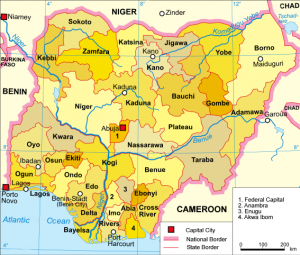 For our Blog Competition 2013, we asked people to submit articles addressing one of two topics. Omeye’s article discusses a recent flooding event that resulted in disaster in Nigeria, and his entry was highly commended by our judging panel.
For our Blog Competition 2013, we asked people to submit articles addressing one of two topics. Omeye’s article discusses a recent flooding event that resulted in disaster in Nigeria, and his entry was highly commended by our judging panel.
Omeye is a second year geology student at the University of Nigeria, Nsukka. When he graduates, Omeye wants to work as a geologist and have a positive impact on his nation. Omeye is currently editor-in-chief of the society for exploration geophysics, and plans to publish a magazine on how geologists can tackle issues of global poverty.

Political map of Nigeria’s 36 states. Source: Wiki
A flood is the unusual presence of water on land to a depth that affects normal activities. Floods are a natural occurrence, yet their impact can be controlled by man. A flood in itself is not disastrous, it becomes so only when people are not prepared for it, early warnings are flagrantly ignored and mitigation measures are not put in place. In July 2012 Nigeria experienced the worst flooding in over 40 years, with 30 of the country’s 36 states affected, according to the National Emergency Management Agency (NEMA). The floods brought many social and cultural consequences to the country – reports shows people clinging to trees to stay afloat and alive. In Benue state all those on the banks of river Benue woke up to discover that water had entered their houses. Like a nightmare, a step on the floor from their bed was a step on water, for some up to waist level.
“We woke up inside water”, one of the victims of the flooding lamented. With the plethora of canoes now plying the areas in Anambra state, you could easily mistake the terrain for a pure river line area. It caused many problems such as limiting the movement of people and thereby depressing the economy of the area. Some communities lost properties worth billions of naira. Even churches, police stations, law courts and schools were totally submerged.
The response of the local government, NGOs, and the international community was encouraging as members and officials of NEMA, and that of the Nigerian red cross society were helpful in ensuring that the displaced persons had access to good medicare and food. First ladies of different states and local government areas were also on hand to extend assistance and aid to children, women and families. On 9th October, president Jonathan Goodluck allocated 17.6 billion Naira (0.11 billion USD) to states and agencies to respond to flood damage, as well as setting up a committee to lead flood relief and rehabilitation efforts. Several international NGOs, including Oxfam, have launched responses, while the NRC responded in 10 states and appealed for 850,000 US dollars to boost their efforts. Some government agencies provided as many tents, healthcare services and basics (such as cooking utensils) as they could from their warehouses in different parts of the country. Many governors also released huge sums of money for the purchase of relief materials for the victims.

Canoes being used in flooded areas. Source: The Watchers
In order to reduce risk in future disasters, possible actions include government implementation of a master plan for areas that are prone to flooding. The government should expedite action on the construction of major embankments on rivers such as river Benue to keep off flood water. Also, the government in conjunction with civil society groups, NGOs and other organizations must embark on aggressive environmental awareness campaign and build capacity to reduce people’s vulnerability – communities living in flood plains should be helped to relocate to higher grounds on time. Finally, the state emergency management agencies must be fully equipped to take on the onerous task of combating disasters. It is agonizing that in several states, the agency lacks functional and even the institutional framework to manage disasters. This has often led to escalation of the damage.
